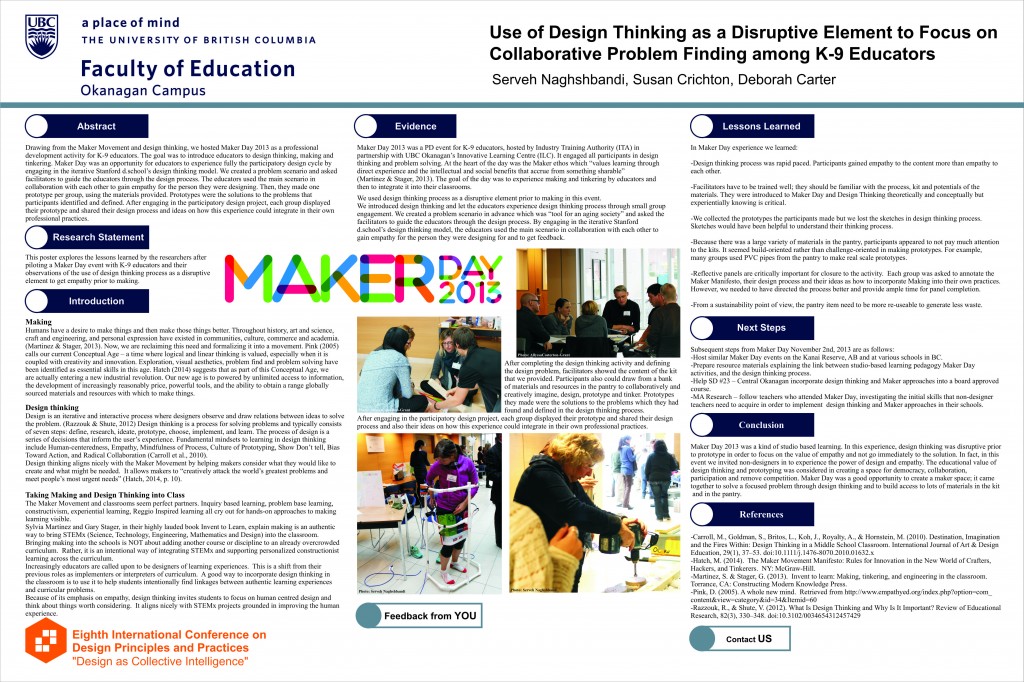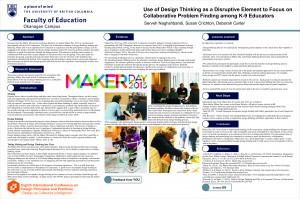Category Archives: Maker
2014 Conference on Design Principles and Practices
At the Eighth International Conference on Design Principles and Practices, Serveh Naghshbandi presented our initial findings from Maker Day 2013. A short video explaining the day and our abstract below provides more information. Looking forward to your comments, Serveh, Susan and Deb.
 |
Drawing from the Maker Movement and design thinking, we hosted Maker Day 2013 as a professional development activity for K-9 educators. The goal was to introduce educators to design thinking, making and tinkering. Maker Day was an opportunity for educators to experience fully the participatory design cycle by engaging in the iterative Stanford d.school’s design thinking model. We created a problem scenario and asked facilitators to guide the educators through the design process. The educators used the main scenario in collaboration with each other to gain empathy for the person they were designing. Then, they made one prototype per group, using the materials provided. Prototypes were the solutions to the problems that participants identified and defined. After engaging in the participatory design project, each group displayed their prototype and shared their design process and ideas on how this experience could integrate in their own professional practices.
Gamestorming – Icebreakers
Low Tech social networking – we used this on Shane Austin’s suggestion for Maker Day 2013 Opening activity.
http://www.gogamestorm.com/?p=477
ITA presentation slides
Attached please find a pdf of the power point presentation from ITA’s Youth Day 2013 Taking Making Into the Schools
Girls and engineering … YouTube …
From Tedx, YouTube:
Close your eyes and picture an engineer. You probably weren’t envisioning Debbie Sterling. Debbie Sterling is an engineer and founder of GoldieBlox, a toy company out to inspire the next generation of female engineers…
See entire video…
Maker Day 2013 Video and News
Want to know more about …
- Watch a three-minute video on Maker Day 2013
- View ITA Maker Day 2013 Flickr account
- Read the Wall Street Journal Press Release on Maker Day 2013
- Visit the Youth in Trades Maker Day 2013 webpage
Questions or Comments: Contact Susan Crichton, director, Innovative Learning Centre
Maker Day Tool Kit – Revised July 2014
Epublication:
To download a pdf of Maker DayToolKit (as of Mar.27/2014)
Thanks to excellent collaboration and support from Erin Johnson and her team at Industry Training Authority (ITA – http://www.itabc.ca/ ) and Nancy Darling and her team from the Women in Trades program at Okanagan College, the ILC hosted Maker Day 2013.
 Educators, Ministry of Education folks, ITA folks all came together to design, tinker and create. The following resources were development to help others create their own Maker Day events. Use and enjoy!!!
Educators, Ministry of Education folks, ITA folks all came together to design, tinker and create. The following resources were development to help others create their own Maker Day events. Use and enjoy!!!
If you downloaded this resource earlier – this is a new version as of July 7, 2014

Maker Day Tool Kit by Dr. Susan Crichton and Deb Carter, PhD (C) is licensed under a Creative Commons Attribution-NonCommercial-ShareAlike 4.0 International License.
From the ePub
What is a Maker Day? (pp. 4-5)
4. Globe and Mail: “Where did all our skilled workers go?” (pp. 18-19)
How to plan and host a Maker Day
7. Group Facilitators’ Roles and Responsibilities (pp. 24-29)
What is needed to host a Maker Day?
Resources to Support Your Maker Day
We did the low-tech social networking activity. It worked well. We invited participants to make their initial contributions during the registration process and before the event actually started. We encouraged them to revisit the activity during the day to make additional connections. Make sure to use paper that is more SQUARE than linear to encourage a range of connections. unfortunately, we used a long piece of paper and the connections were harder to make.
Appendix
20. Required Materials (pp. 46-49)
Word documents are provided in #15 and #16 above.
Additional Resources
These resources (not in ePub or printed Maker Day Toolkit) have been gathered during multiple formal and informal discussions of Maker Day Toolkit
Note: To download free resource (bottom left hand corner), you are asked to join HCD Connect (free)
From the website: This toolkit contains the process and methods of design along with the Designer’s Workbook, adapted specifically for the context of K-12 education.
Links on this page includes Gift Giving Project, the Wallet Project pdf and Design Process Mini Guide
Suggested by teachers in EDST 498O class during Summer Institute in Education 2014
Buck Institute for Education (BIE) Problem Based Learning (PBL)
All about PBL including a Project Search curated by BiE. From the website: At the Buck Institute for Education (BIE), our highest priority is to help teachers prepare students for successful lives … As a mission-driven nonprofit organization, BIE creates, gathers, and shares high-quality PBL instructional practices and products and provides highly effective services to teachers, schools, and districts.
From the website: Catalyst for Science provides an online collection of science-based resources primarily for BC teachers, and shares these resources with non-formal educators, parents and students … Example: Easy Squeasy Circuits
Media Release
Vancouver Links
Met a terrific young man recently who is heading up some exciting Maker things in the Vancouver area …
Vancouver Maker Education Meetup <http://www.meetup.com/Vancouver-Maker-Education-Meetup/


